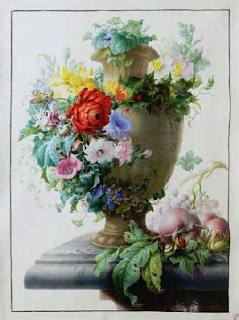We invite you learn about one of the most prolific botanical artists of the French 18th and early 19th Century Pierre-Joseph Redouté. Scroll down to also view our Flower Power Guide linking you to Exhibitions and Event showcasing floral Artworks.
Rosa Gallica Maheka, From: Les Roses
Redouté
(1759-1840) is unquestionably the best-known botanical illustrator of any era.
The decorative appeal of his original engravings has led to their modern
reproduction, which in turn has popularized Redouté’s work in a way unique
among botanical artists. Yet no reproduction can capture the great and subtle
beauty of his original engravings from Les Roses,
nor can any introductory paragraph fully describe his many achievements. These
magnificent engravings demonstrate the full mastery of his abilities, as the
forms of the roses are set off dramatically by Redouté’s masterful and rich
modulations of tone and hue.

The regal simplicity of the compositions allows the viewer to focus without distraction on the beauty and delicate complexity of the plants themselves. Perhaps better than any other engravings that the artist ever made, these three images demonstrate the flawless and pristine French style of botanical art that Redouté pioneered and brought to a pinnacle of quality. The
luminosity of stipple engraving, a technique perfected by Redouté, is
particularly suited to the reproduction of botanical detail. The medium
involved engraving a copper plate with a dense grid of dots that could be
modulated to convey delicate gradations of color.
FLOWER POWER GUIDE
Various museums in San Francisco are showcasing amazing botanical artwork as an homage to the 50th anniversary of the Summer of Love, celebrating Flower Power as major themes of Peace, Love, and Community. We also added some exhibitions abroad for those traveler's this summer!
Flower Exhibitions and Events:
Floral Artwork of the Buddhist tradition
The largest west coat annual Antique show will host antique dealer, art galleries, and designers showcasing works with a floral themes in mind.
Garden of Shakespeare's Flowers, Golden Gate Park
Flowers and plants played an important tool for Shakespeare's plays, here you can see many of those flowers he mentioned in his writing.
Musee de la Vie Romantique
Showcasing the works of Redouté from his Roses to the Lillies
The Metropolitan Museum of Art
Look out for a future exhibition which will showcase our own collection of the Raphael of Flowers, Redouté!
Flowers and plants played an important tool for Shakespeare's plays, here you can see many of those flowers he mentioned in his writing.
Musee de la Vie Romantique
Showcasing the works of Redouté from his Roses to the Lillies
The Metropolitan Museum of Art
Look out for a future exhibition which will showcase our own collection of the Raphael of Flowers, Redouté!
For Inquiries Please Contact us at (415) 788-5115, or Visit us at 432 Jacskson St. San Francisc, Ca 94111. Aradersf.com




















